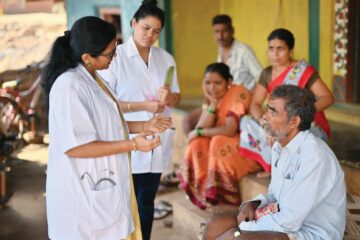
Caribbean Countries Pay for Successfully Addressing Population Issues
Date
April 22, 2002
Author
(April 2002) In a move that marks the Caribbean’s success in various spheres of socioeconomic activity, international funding agencies are reducing their financial support for the region’s sexual and reproductive health programs. The move could adversely affect the delivery of population services — including those designed to stop the spread of HIV/AIDS — unless alternate sources of funding are found.
The United Nations Population Fund (UNFPA), the International Planned Parenthood Federation (IPPF), and the World Bank have all signaled that the region has achieved success in socioeconomic development (including various population activities) and therefore should not continue to receive current levels of assistance. As a result, some countries will see their assistance phased out altogether while others will have their funding reduced over time.
Population Characteristics
This process of “graduation” from international assistance follows achievements in addressing a number of population problems. Infant mortality, birth rates, and population growth have declined during the last decade or so and the decline has been rapid in some cases.1 As a consequence, population growth has slowed while life expectancy at birth continues to rise.
Total fertility rates (TFRs) are expected to decline significantly for most countries over the next decade. In Belize, for example, the average number of children per woman is estimated to decline by more than 58 percent — from 5.4 in 1980-1985 to 2.6 in 2005-2010. A decline of some 53 percent is projected for Trinidad and Tobago, with the TFR dropping from 3.2 to 1.6 during the period.2 Haiti recorded the highest number of children per woman during 1980-1985 with 6.2, but this number is expected to decline by 40 percent (to 3.6) by 2005-2010.
Crude death rates or deaths per 1,000 people are also declining in the region. Countries estimated to record the highest declines during the periods 1980-1985 and 2005-2010 include Haiti (a 42.7 percent decline), Belize (35.1 percent), Guyana (23.9 percent), and the Dominican Republic (23.5 percent).
As a direct consequence of this declining mortality (from all causes of death including AIDS), life expectancy at birth has been increasing. Guadeloupe is estimated to record the highest life expectancy at birth of 76.0 years (males) and 82.5 years (females) during 2005-2010, an increase of 10.3 percent for men and 8.3 percent for women over the figures for the 1980-1985 period. Haiti (18.2 percent for males and 17.8 percent for females) is projected to record the highest percentage change in life expectancy during the 1980-1985 to 2005-2010 period, although the actual life expectancy at birth is estimated to be a modest 59.8 years for males and 62.8 years for females during 2005-2010.3
In line with declining fertility and mortality and limited net international migration, population growth rates are expected to remain low in the Caribbean.4 Cuba is expected to record the highest decline in the population growth rate, going from 0.8 percent during 1980-1985 to 0.3 percent during 2005-2010 — a nearly 63 percent drop. Estimates for Trinidad and Tobago show the growth rate falling from 1.7 percent during 1980-1985 to 0.5 percent in 1995-2000, before rising slightly to 0.7 percent in 2005-2010. The growth rate for the Dominican Republic is expected to go from 2.3 percent in 1980-1985 to 1.3 percent during 2005-2010, while in Jamaica the rate is expected to decline from 1.5 percent to 0.9 percent.
The Price
This overall success is costing the Caribbean international support for its population activities. UNFPA prioritizes and allocates funds to developing countries according to population needs. Most Caribbean countries have been placed in category B in the last five years (mid-level need) and slated for funding reduction, while the Bahamas and Barbados have been placed in category C (low-level need) and slated for a funding phase out.5
Many international agencies use the UNFPA classification to make funding decisions. The IPPF has announced its decision to phase out funding for some Caribbean countries and drastically implement a phased reduction in funds for many others. While the IPPF decision is also the result of a reduction in funding from the Federation’s own donors, other international agencies may follow suit. These cuts are expected to have a far-reaching impact. Until recently, for example, many Caribbean family planning programs received a substantial amount of funding from the IPPF.
While some governments already provide support for these programs, many are unlikely to be able to meet the funding shortfall. Governments such as Barbados and Trinidad and Tobago already spend substantial amounts of funds on their countries’ family planning programs. Others, including Grenada and Antigua and Barbuda, allow family planning associations to import supplies without customs duties and offer other non-cash concessions.
Emerging Population Issues
While the UNFPA reclassification was based on demographic data in the early to mid-1990s, new population challenges are emerging in the region. Notable among them are population aging, HIV/AIDS, and the need to sustain the levels of fertility, mortality, population growth, and related achievements that resulted in the reclassification.
Population Aging
Falling fertility and mortality and increasing life expectancy at birth provide a good mix for population aging and for increases in the proportion of older people in the population. The proportion of the population 65 years of age and older is expected to increase throughout the region between 1990 and 2020. In the Bahamas, where the largest percentage change is expected to occur, the proportion of the population 65 years old and older is expected to increase from 4.6 percent to 9 percent over the 30-year period. Cuba and Guyana are also expected to record massive changes in the proportion of older people.6 For Cuba, the proportion will increase from 8.4 percent to 15.8 percent. In Guyana the proportion of older people is expected to increase from 3.4 percent to 7.0 percent.
The increasing proportion of older people in the population brings with it a host of socioeconomic issues that will have to be addressed by these countries, including increased demand for health care, housing, recreation, transportation and other geriatric services and programs, with inherent implications for funding.
HIV/AIDS
The Caribbean has the second highest prevalence rate of HIV/AIDS in the world (2.2 percent) after sub-Saharan Africa (8.4 percent). While there are wide variations in the region, the largest number of people living with HIV/AIDS is found in Haiti where 200,000 adults ages 15-49 and 5,200 children under 15 years have the virus (see table below).
Table 1
Estimated Number of People Living with HIV/AIDS and Deaths by Country, 1999
| People living with HIV/AIDS | Deaths | ||||
|---|---|---|---|---|---|
| Country | Adults (15-49) | Adult HIV prevalence rate | Women (15-49) | Children (0-15) | All ages |
| Bahamas | 6,800 | 4.13 | 2,200 | 150 | 500 |
| Barbados | 1,700 | 1.17 | 570 | <> | 130 |
| Belize | 2,400 | 2.01 | 590 | <> | 170 |
| Cuba | 1,950 | 0.03 | 450 | <> | 120 |
| Dominican Republic | 130,000 | 2.80 | 59,000 | 3,800 | 4,900 |
| Guyana | 15,000 | 3.01 | 4,900 | 140 | 900 |
| Haiti | 200,000 | 5.17 | 67,000 | 5,200 | 23,000 |
| Jamaica | 9,700 | 0.71 | 3,100 | 230 | 650 |
| Suriname | 2,900 | 1.26 | 950 | 110 | 210 |
| Trinidad & Tobago | 7,600 | 1.05 | 2,500 | 180 | 530 |
Source: Compiled from UNAIDS and WHO Epidemiological Fact Sheets.
The Dominican Republic follows Haiti with 130,000 adults and 3,800 children living with HIV or AIDS. Countries with moderate numbers of people living with HIV/AIDS include Guyana with 15,000 adults and 140 children, Jamaica with 9,700 adults and 230 children, Trinidad and Tobago with 7,600 adults, and the Bahamas with 6,800 adults and 150 children. Barbados, Cuba, Belize, and Suriname have the fewest people living with HIV/AIDS (see table above).
AIDS-related mortality is low in the Dominican Republic and moderate to high in the other countries, especially Haiti. The largest number of AIDS deaths in 1999 occurred in Haiti (23,000 deaths) and this constituted 11.2 percent of the total number of people living with the disease that year (see table above). The Dominican Republic recorded the second largest number of deaths with 4,900, but this constituted the lowest proportion of deaths of only 3.7 percent. Death proportions from AIDS were moderately higher in Cuba (5.6 percent) and Guyana (5.9 percent). The numbers were higher in the Bahamas (500 and 7.2 percent), Barbados (130 and 7.2 percent), Suriname (210 and 7.0 percent), Trinidad and Tobago (530 and 6.8 percent), and Belize (170 and 6.8 percent).
Most local family planning associations have been dealing with HIV/AIDS prevention at the grassroots level, including through programs in schools and through community outreach projects. According to the Barbados Ministry of Education, sexual activity is rife among school children in the country: children as young as 9 years old are involved in such activity, increasing their risk of contracting sexually transmitted infections, including HIV.7 A survey of family planning associations indicates that many would cut services if the shortfall from declining international funding is not found elsewhere.8 HIV/AIDS services are likely to be curtailed as part of these overall service cuts.
In the meantime, governments in the region are setting up national advisory councils and national commissions on AIDS as they try to curb the epidemic’s spread and impact. Caribbean Community (CARICOM) members have also agreed to adopt a regional approach to tackling HIV/AIDS, and discussions are afoot among member states about how this regional approach would be funded and implemented. The role of the family planning associations in this new approach is unclear at this stage, but it is hoped that they would be funded to continue work at the grassroots level since they have the potential to contribute significantly to any anti-AIDS efforts.
Conclusion
The Caribbean’s success in addressing population issues was achieved with a certain level of funding, without which the gains may be lost. The end of preferential trade status with the European Union, globalization, and trade liberalization, as well as fall out from the September 11 attacks on the United States (especially in relation to tourism) are adversely affecting revenues, and there can be no guarantee that the Caribbean countries will continue to maintain their current levels of income generation and economic growth. Some of the more developed countries in the region, such as Barbados, are technically in a recession (having recorded a third consecutive year of declining economic growth).9
The problem is exacerbated by competition from other sources of government expenditure, and it is most unlikely that many governments will be able to meet the shortfalls in international funding. The results could be devastating for the region in view of the emerging population issues and the need to sustain levels of success.
David Achanfuo Yeboah is senior fellow and inter-campus coordinator of the Special Studies and Research Methods Unit at the Sir Arthur Lewis Institute of Social and Economic Studies, the University of the West Indies, in Cave Hill, Barbados.
References
- 1. D. A. Yeboah, “A Demographic Profile of the Caribbean,” CARICOM Perspectives, no. 70 (2001): 104-105.
- United Nations Economic Commission for Latin America and the Caribbean (ECLAC), Statistical Yearbook for Latin America and the Caribbean (Santiago: ECLAC, 1999); and Yeboah, “A Demographic Profile of the Caribbean.”
- ECLAC, Statistical Yearbook for Latin America and the Caribbean.
- D.A.Yeboah, “A Demographic Profile of the Caribbean.
- D.A. Yeboah, “Strategies Adopted by Caribbean Family Planning Associations to Address the Challenges of Declining International Funding,” International Family Planning Perspectives (forthcoming, June 2002).
- ECLAC, Statistical Yearbook for Latin America and the Caribbean; and Yeboah, “A Demographic Profile of the Caribbean.”
- Barbados Ministry of Education, A Survey of Sexual Behaviour Among School Children (Bridgetown: Ministry of Education, 2001); and Ruben del Prado, United Nations Press Conference on AIDS, Port-of-Spain, Trinidad and Tobago, December 7, 2001.
- D. A. Yeboah, “Strategies Adopted by Caribbean Family Planning Associations to Address the Challenges of Declining International Funding.”
- “Third Year of Decline: Report of the Governor of the Barbados Central Bank,” Nation (Barbados), January 31, 2002.<.li>

Early Sexual Activity Raises HIV Risk for Trinidad and Tobago Girls
(December 2000) Jean Jones (not her real name) spent most of her childhood and early teens at a home for children. At 15, she got lucky and went to live with relatives. At 16, however, she had a son, discovered that she had HIV, and that her relatives no longer wanted her around.
Jones and her seemingly healthy 5-year-old son now live at the home of a health worker.
“Sometimes, I just cry; I don’t eat, and I get sick all the time. I know I’ll die sometime soon, but I’m not too worried about myself; it’s my son I am concerned about,” says Jones, bundled up at the edge of a bed in the health worker’s modest home.
Six Times as Many Girls as Boys 15-19 Years Have HIV in Trinidad and Tobago
Jones’ HIV/AIDS condition is replicated many times over among the young female population of Trinidad and Tobago. In the age group 15–19 years, six times as many young women as young men have HIV. This is a dramatic turnaround of the numbers over the last five years. It has come about because of certain factors, including early sexual initiation.
A survey was conducted of 676 young adults (10–29 years old) in Tobago in April by the Family Planning Association; the Tobago AIDS Society; the Caribbean Epidemiology Centre, with support from the Dutch Embassy in Trinidad and Tobago; and the German Technical Cooperation Agency in Tobago. The study found that sexual activity starts as early as 10 years old, the average age being 14 years old for boys and girls combined. Thirteen percent of those 10–14 years old had had sex.
The overall young age of sexual initiation as reported by the study reaffirms that young people between the ages of 10 and 24 years are at high risk of acquiring HIV infection, states the report of the survey.
Young Women Have Older Partners
Along with the quantitative findings, focus groups were also conducted. Participants of these groups remarked on the phenomenon of young women having sex with older men, where materialism plays a role. The report points out that older men are usually able to afford more enticements. It notes that the men take advantage of their more favorable financial positions when they seek relationships with young girls. Unfortunately, a consequence of this age differential between males and females in sexual relationships is that the young women are more susceptible to HIV infection.
Incest, a subject that is not talked about or acknowledged, has a heavy impact on girls. Six percent of the young people surveyed — all girls — said they had had sex with a father, stepfather, uncle, or older brother.
Some girls did not see anything wrong with having sex with a member of the family, says Anne-Marie De Gazon-Washington, a youth officer who was part of the team that conducted the survey. “If that is so, you have to consider how that translates into risky, grown-up behavior.”
Young Mothers Are Passing the Virus to Their Babies
A key problem that goes along with rising sexual activity and HIV transmission among young people is the increasing number of young women who transfer the virus to their babies. At the Tobago Regional Health Authority hospital in the capital, Scarborough, HIV testing was conducted on the umbilical cords of newborn babies. The infection rate of the babies of mothers in the 14-24 age group was about 3.6 percent — roughly double the rate for older women.
Addressing these potentially infected babies is urgent.
“If something is not done about mother-to-child transmission, we run the risk of realizing the international norm of 30 percent of the babies born to HIV-positive mothers contracting the virus,” says the hospital medical director of Tobago, Dr. Maria Dillon-Remy. That would severely affect the 750 babies born in Tobago every year and eventually the 50,000 population of the island, Dr. Dillon-Remy observed.
Dr. Violet Duke of the Ministry of Health in Trinidad says the government has developed a policy that includes voluntary screening for pregnant women. The next stage is to provide treatment for mothers who develop AIDS after having their babies, “otherwise we will have a generation of orphans,” notes Duke. The third stage of the policy would be to begin making combination HIV drug therapy available to persons infected with AIDS.
Under the new policy, a pilot study began in August 1999 with voluntary screening of women for HIV. With the assistance of the Medical Research Foundation of Trinidad and Tobago, six women were treated during pregnancy and, along with their babies, they also received treatment during delivery with AZT. Five other babies whose mothers had not received the drug during pregnancy received AZT treatment. Only one of the 11 babies among those women who were treated has developed the virus.
Given the study results, “We hope to soon be able to offer universal screening to all mothers,” says Dr. Dillon-Remy, noting that the incentive given to women with HIV that their babies can be spared the virus “has proven to be the most important reason why mothers are taking the test.”
Some Teenagers Say the Problem of High-Risk Sexual Behavior Begins at Home
Young people have their own ideas about the reasons for early sexual activity among their peers.
Adana Clarke, 18, says one reason that young people, especially girls, assume high-risk behavior at an early age has to do with the failure of parents to speak with their children about sex, postponing the issue until the young people are all but out of their teenage years.
Referring specifically to girls, she adds that “a lot of young people are not given love and affection in their homes, and when they get out onto the streets and the fellas tell them ‘I love you,’ they feel wanted. And because they have low self-esteem, they are forced into sexual behavior at an early age.”
Charles Smith, just out of high school, says parents employ a double standard that is also contributing to the spread of the virus in Tobago. He notes that while parents caution their girls about “appropriate behavior,” they leave their boys “to do as they wish.”
Policy Recommendations Include Services for Young People
Policy recommendations coming out of a workshop on the Sexual Health Needs of Youth in Tobago include the establishment of youth empowerment centers where young people can go for lifestyle counseling and adolescent and health services without the stigma of visiting an AIDS clinic for testing.
One policy approach recommended is the reorientation of health services in order to create youth-friendly, youth-specific approaches to sexual and reproductive health. The young people fear for confidentiality in a small society.
One desire of the youths is for the government and the Tobago House of Assembly, the body responsible for the administration of the local affairs of Tobago, to adopt a policy of having an official youth representative in the Assembly to look after the interests of young people.
One important policy recommendation, however, is for sex education to be offered at school as well as at home. Another calls for increasing the self-esteem of young girls, “especially to have girls who are sexually violated by fathers and uncles begin to understand that it is wrong, and to end the culture of silence about sex in our society,” says youth officer, Anne-Marie De Gazon-Washington.
Tony Fraser is a freelance writer in Trinidad.






